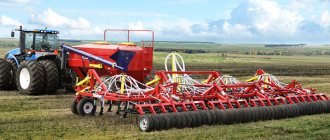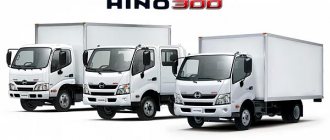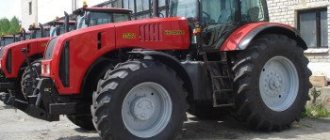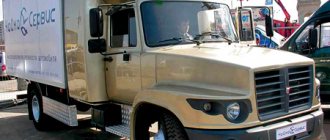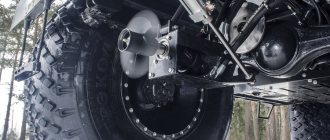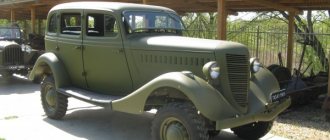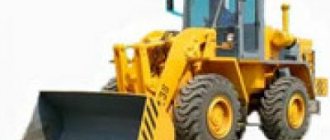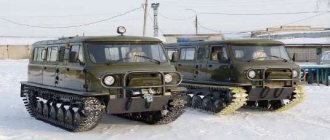The GAZ-71 tracked transporter is a truly unique and universal design. The vehicle can be used to transport cargo, personnel or tow trailers in off-road conditions. The sealed conveyor body allows you to cross water obstacles without any preparation of the machine.
The car was widely used in the northern regions, where it received a lot of nicknames - “Brute Dumb Force”, “Gasushka” or “Zhuzhik”. The GAZ-71 design had great potential for development and modernization. Currently, GAZ-3403 transporters are being produced, slightly different from their predecessor.
History of the creation of the all-terrain vehicle
The development of the GAZ-71 transporter began in the 60s. The vehicle was created on the basis of the GAZ-47 snow and swamp-going vehicle produced since 1955.
The characteristics of serial products began to lag behind the requirements of the main customer - the Soviet Army. It was planned to equip the new tracked all-terrain vehicle with a power unit and transmission unified with the components of the GAZ-66 wheeled army all-terrain vehicle.
The first prototype of the new tracked transporter was assembled in 1965.
A design feature of the experimental vehicles were plastic road wheels. However, the low strength of parts led to the abandonment of the use of plastic in serial products.
The new all-terrain vehicle used expanded caterpillar links, which, together with an increase in the length of the supporting surface, made it possible to reduce the pressure on the ground to 0.071 kgf/cm².
Serial production started in 1968 under the designation GT-SM. In the first years, the production of vehicles was carried out in Gorky, but due to the workload of the plant, production was moved to Zavolzhsk to a specialized plant for tracked tractors. The assembly of the conveyor in Zavolzhsk continued until 1985.
Main components of the all-terrain vehicle
The main components, such as the gearbox, engine, differential, brake system, headlights and lanterns and shock absorbers, were largely borrowed from production cars, trucks and all-terrain vehicles. This made it possible to reduce the cost of new GAZ all-terrain vehicles, reduce production time, and significantly improve maintainability and the ability to supply spare parts. Since the operation of GAZ all-terrain vehicles was intended in places remote from cities, service centers and repair bases, the use of the units listed above was a significant advantage over imported all-terrain vehicles, for the repair of which you need to order spare parts and wait several weeks. All this allowed the GAZ-69 all-terrain vehicle to become a people's favorite. Excellent all-terrain properties: all-wheel drive, ground clearance (210 mm), 6-speed gearbox, small dimensions, excellent balancing and weight distribution along the axles, a well-designed transmission allowed the all-terrain vehicle to move through virgin snow and mud. Initially, the GAZ-69 all-terrain vehicle was produced in a two-door body: two passengers were seated in front, and six more on benches in the rear compartment. To transport loads up to 500 kg, the benches could be folded. Also, GAZ-69 all-terrain vehicles were capable of towing a trailer weighing up to 850 kg. The GAZ-704 trailer, capable of transporting up to 500 kg of cargo, was designed especially for the GAZ-69. Also, the GAZ-69 all-terrain vehicles had a folding tailgate and it was possible to install a stretcher, this allowed the use of all-terrain vehicles in emergency situations by the Ministry of Emergency Situations. The cabin had a heater, which was rare for that time. Engine - Four-cylinder lower valve with a capacity of 55 hp. With. , unified with "Victory". To start the engine, a pre-heater was installed, which heated the water in the cooling system.
Frame
At the heart of the GAZ-71 conveyor is a steel body welded from sheets of various thicknesses. The body is sealed, which allows the vehicle to overcome water obstacles without special training.
The body is divided into three sections:
- cabin;
- engine compartment;
- cargo platform.
The engine compartment is separated from the cabin and cargo part of the transporter by steel bulkheads. The bulkheads have removable hatches designed for servicing the power unit. A pump is installed in the engine compartment, designed to pump out liquid that enters when overcoming water barriers.
The GAZ-71 cabin is completely metal, equipped with two seats: for the driver and passenger.
Access to the cabin is through hinged side doors or through two hatches in the roof. The loading platform is made directly in the conveyor body. To facilitate unloading and loading, the upper part of the tailgate is hinged.
On the sides of the platform there are folding semi-soft seats. The platform is covered from above with a tarpaulin awning mounted on arches. To heat the internal volume of the cargo compartment, a separate liquid-type heater is used.
GAZ 34039-0000032 with rubber-metal hinge (RMSh)
Equipment: passenger, engine. D245, autonomous engine heater PZHB-18, autonomous passenger compartment heater Pramotronik 4D-24, number of seats 10 (2+8), incl. sleeping -4, metal. body, headlight finder
Values Maximum technically permissible weight, kg. 6000 Weight of equipped snow and swamp-going vehicle (without cargo and crew) kg. 4900 Load capacity, kg. 1100 Permissible total weight of the towed trailer, kg. 2000 Number of seats in the cabin 2 in the body (including sleepers) 8 (4) Average specific ground pressure, kPa (kgf/cm2) 21.4 (0.214) Engine D245.12S diesel, in-line 4-cylinder with turbocharged: power, kW (hp) gross 80 (108.8) maximum torque, N*m (kgf*m) 353 (36.0) Engine displacement, cm3 4750 Gearbox (gearbox), type mechanical Number of gears, units, not less than 5 Main gear Gearbox, parameters in a monoblock with an additional gear Steering controls levers Guide wheel (suspended sloth roller) availability Maximum speed, km/h on highway 60 afloat 5 Overall dimensions, mm. : length 5720 width 2550 height 2175 Internal body dimensions, mm: length 2706 width 1678 height 1600 Track, mm. 2150 Base, mm. 3600 Maximum design speed, km/h 60 Ground clearance, with full load mm, not less than 400 Forged track width, mm 390 Number of road wheels, pcs. 6 The location of the drive wheels is front. Climbing angle, degrees 35. Average fuel consumption from 45 l/100 km. Fuel range on the highway, km. 900 On-board voltage, V 24 Design of the driver's cabin Separate, isolated from the engine and passenger compartment, a two-seater cabin, two doors on the right and left sides. Two hatches on the cab roof above the driver and passenger seats. Engine compartment design The engine compartment, isolated from other compartments, is located in the middle part of the all-terrain vehicle between the cabin and the passenger compartment. Design of the passenger compartment. A metal passenger compartment isolated from the cabin and engine compartment, a hatch on the roof of the compartment, a folding table in the passenger compartment, an entrance door in the rear wall of the passenger compartment. Number and location of fuel tanks: 4 pcs., located in niches, on the right and left sides of the body, outside. Body color green Requirements for PSM Availability of a mark on payment of the Utilization fee in the PSM*RMSh – rubber-metal hinge, track life 12,000 km.
Engine
The GAZ-71 conveyor is equipped with a gasoline power unit with a carburetor fuel supply system. The engine has eight cylinders with a displacement of 4250 cm³ (4.25 l). Structurally, the engine is a modification of the power unit from GAZ-66 trucks. The engine develops a power of 115 hp.
Gasoline A-76 or AI-93 is used as fuel.
The plant allowed the engine to run on A-72 gasoline when installing an octane corrector for later ignition.
A special feature of the engine design is the installation of a standard P-16 heater running on gasoline. The heater warms up the coolant and oil in the crankcase for starting at low ambient temperatures.
Varieties
For twenty-nine years, from 1985 to the present, GAZ has produced several modifications of the passenger and cargo versions of the “34039”.
In addition, special all-terrain tractors for various purposes are produced on its platform:
- «34039-12» is a passenger version of an all-terrain vehicle with a double insulated awning and double glazing. It has an autonomous Webasto heater in the body. Caterpillars with "RMSh".
- «34039-13» - has the same configuration as “34039-12”, only the caterpillar track with “OSH”.
- «34039-22» - a cargo version of a tracked all-terrain vehicle with a lightweight awning and tracked tracks with "RMSh", can, if necessary, transport passengers.
- «34039-23» - the equipment and purpose are the same as the “34039-22”, but the caterpillar track is with “OSH”.
- «34039-32» — the car is made for transporting passengers, the body is completely metal, insulated, with a separate autonomous heater and “RMSh” tracks.
- «34039-33» — a passenger version with the “34039-32” configuration, with “OSH” tracks on the chassis.
- In 2011, the model was put into mass production. "34039 Irbis". It is made on the platform of the classic swamp rover “34039”.
The body of the new car is fundamentally different; it is made of special plastic, due to which the carrying capacity of the conveyor has increased to two tons.The cabin is combined with a cargo-passenger compartment: this is a more convenient and comfortable option for the driver, especially if it is necessary to work with the engine in the field in difficult conditions.
This machine also has a more powerful 122 hp diesel engine. With.
- Various special all-terrain vehicles are manufactured on the basis of “34039”, primarily such as “34094” - a specialized emergency medical vehicle.
An additional independent air heater is installed in its body, and an air conditioner is installed on the roof. Caterpillar belt "RMSh". - Geologists and seismologists in the Far North and Siberian taiga widely use the SVP-6-02 .
This is a self-propelled blasting point, which is used in seismic exploration and other types of blasting operations. - “34039 – UGB-001” — hydraulically driven drilling rig with a drilling depth of 50 to 100 m, depending on the method.
Thanks to its all-terrain qualities and self-propelledness, it is used by various services for drilling rocks up to category VI in terms of drillability, including permafrost soils.By agreement with customers, the manufacturer can install other types of drilling machines, such as, for example, BGM-21.
- By special order, a hydraulic lift can be mounted on the machine to perform work on high-rise objects such as power lines or towers.
- With a special configuration of any cargo-passenger version, this swamp vehicle can be used as a vehicle for the Ministry of Emergency Situations and other emergency services.
- These all-terrain transporters are widely used as fire trucks . A Vodoley 10/60 motor pump is mounted on them and OU-2 and OU-5 fire extinguishers are installed. PSB-3 or “Vulcan” is used as a fire extinguishing powder.
- UKTP - “Blizzard 120” - this model is intended for extinguishing particularly fire-hazardous and explosive objects and materials, as well as for creating special curtains and screens in areas of accidents and disasters.
Did you know that thanks to its good technical characteristics, the MTZ-82 tractor can be considered universal when used in agriculture and on construction sites? From this review you will know which of the vehicles in the MAZ-53366 model range are designed for transporting liquids.
By clicking on the following link https://spez-tech.com/tehnika/gruzovie-avto/zil/4331-opisanie-i-harakteristiki.html, you can evaluate the technical characteristics, as well as the advantages and disadvantages of ZIL-4331 trucks.
32nd modification
The main feature of this modification is that the awning was replaced with an insulated metal body. This significantly increased comfort and safety in the passenger compartment. In the conditions of the taiga and tundra, this is an important circumstance.
Installing a caterpillar track with “RMSh” on the chassis of this model significantly increased the maintenance-free service life of the vehicle (about 12,000 kilometers).
A winch with a traction force of 6.8 tons significantly increases the vehicle's maneuverability.
Transmission
The GAZ-71 conveyor is equipped with a mechanical four-speed gearbox and a dry clutch. The clutch design uses one disc with a diameter of 300 mm. The box is equipped with synchronizers in the two highest gears (fourth speed – direct). Switching the first two speeds is performed with throttle reversal. The operating range of the transmission is expanded by installing a transfer gearbox with overdrive and downshift gears.
The torque from the transfer gearbox is supplied to a single-stage main gear installed in an aluminum crankcase. A cardan shaft is used for transmission. Dry friction side clutches are installed at the output of the main pair.
Each clutch consists of 19 discs, which are controlled by a cam mechanism.
Clutches control single-stage final drives with spur gears. Axle shafts with gear couplings are used to connect clutches and gears.
Control
To control the GAZ-71 conveyor, a system of levers and pedals is used. The pedal drive has a throttle valve and a clutch. Switching speeds in the gearbox and transfer gearbox is carried out by separate levers. The rotation is performed by disabling the side clutch clutches, the shutdown drive is carried out using levers.
To control various equipment, buttons and toggle switches located on the instrument panel are used.
Devices
An instrument panel is located on the central part of the dashboard of the GAZ-71 conveyor. On the sides of the shield there are deflectors for blowing hot air onto the windshield. The instrument panel consists of a free-standing speedometer and a rectangular console on which additional instruments, switches and indicator lamps are installed.
Closer to the speedometer there is an engine temperature indicator, behind which there is an oil thermometer, pressure gauge, ammeter and fuel level indicator in the tank. Since the GAZ-71 tracked all-terrain vehicle uses four fuel tanks, the dashboard has a level indicator switch between the tanks. To illuminate the devices, lamps installed above the devices are used.
Main settings
- The geometric dimensions of the machine are 5,720x2,570x2,130 mm.
- The track is 2,180 mm, and the wheelbase is 3,600 mm.
- The body is made with the greatest possible convenience for this car, its length is 2,700 mm, width is 1,670 mm, and height is 1,400 mm.
- The number of seats to accommodate passengers in the body is eight, of which four are sleeping.
- The total weight of the tracked tractor is 5.0 tons, while its load capacity is up to 1,500 kg. The tractor has the ability to tow a trailer with a total weight of 2.0 tons.
- The in-line diesel engine with four cylinders and turbocharging develops a power of 110 hp. s., the torque is 350 Nm.
- The gearbox is five-speed, the main gear is made in a monoblock with an additional gear.
- The fuel capacity in the tank is 370 liters.
- The highest speed on the road is 65 km/h.
- Travel speed on water is 6 km/h.
- The average diesel fuel consumption is 50 liters per 100 kilometers.
- Ground clearance - 400 mm.
- The turning radius is only 2.2 meters.
- The elevation angle of the obstacle being overcome is 35 degrees, and the lateral inclination angle is 25 degrees.
- If necessary, this transport unit can be transported over long distances using KamAZ or MAZ .
From numerous reviews of the technical characteristics of the Baw Fenix 1044, it becomes clear that this is a reliable, easy-to-use vehicle. And here we consider the design features of the 62nd modification of KamAZ-65116.
Caterpillars
The GAZ-71 conveyor uses a steel small-link caterpillar, composed of 83 links each. The link has a width of 390 mm, the distance between the axes of the finger holes is 128 mm.
On the inner surface of the link there are two feathers that limit the treadmill and prevent the track from coming off the track rollers.
The links are connected to each other using steel fingers, secured against falling out with locking rings. To ensure the durability of the finger, the surface is saturated with boron, followed by hardening with high frequency currents. On the body between the first roller and the drive sprocket there is a removable plate that cleans the track from dirt and snow. The tracks are tensioned by turning the guide roller balancer crank.
Rollers
The GAZ-71 conveyor is equipped with six steel road wheels with a diameter of 700 mm with external rubber shock absorption. The rear rollers serve as idler wheels. The rollers are mounted on steel balancers.
The balancer suspension is torsion bar, supplemented with hydraulic shock absorbers. Telescopic shock absorber cartridges are installed on the balancers of the front rollers and idler wheels. The drive wheels are located at the front. The ring gear is equipped with 12 teeth, the unit is removable and interchangeable.
Specifications
The main parameters of vehicles based on GAZ-71 are given below:
| Parameter | GAZ-71 | GAZ-34039 | GT-MU |
| Length, mm | 5390 | 5720 | 5146 |
| Width, mm | 2582 | 2550 | 2470 |
| Height, mm | 1740 | 2040 | 1700 |
| Load capacity, kg | 1000 | 1500 | — |
| Trailer weight, kg | 2000 | 200 | — |
| Curb weight, kg | 4950 | 4900 | 5800 |
| Capacity, persons | 10 | 12 | 8-10 |
The overall dimensions of the GAZ-71 allow the vehicles to be placed on a railway platform in pairs.
Application
Civilian transporters GAZ-71 are widely used in the Far North and Far East, where they make up a significant share of the fleet of all-terrain vehicles and tractors. The machine is used for delivery and supply of geological parties. Mobile drilling rigs were installed on the GAZ-71 base with equipment located on the front or rear of the hull.
An interesting modification of the machine is the installation for ice fishing (PT-ILT). In addition, on the basis of the GAZ-71, fire engines VPL-149A, short-circuit stations SKS-1A-02 and a number of other equipment were produced.
GAZ-71 all-terrain vehicles were used in the army to deliver personnel, small arms and mortars, and ammunition. The vehicle is designed to transport 10 people. The cargo compartment of the transporter can be used to transport the wounded on stretchers.
By order of the KGB border troops, border variants were produced under the designation GMP and GMP-1.
The equipment included night vision devices and various radio equipment. The roof of the driver's cabin was equipped with machine gun mounting points. A search and rescue version of the GT-PS was produced for the military space forces.
Based on the GAZ-71, the GT-MU airborne armored personnel carrier was developed. The upper part of the vehicle was protected by armor 4-6 mm thick; the bottom was made of ordinary steel sheet. The chassis has been shortened by one roller to reduce dimensions and reduce weight. The armored personnel carrier could be equipped with gasoline or diesel power units.
GAZ-3402D vehicles are equipped with a chassis identical to the GAZ-71. On the meringue GT-MU there were sanitary versions equipped with a cable winch for evacuating stretchers with the wounded. Combat vehicles could be used as artillery tractors or chemical reconnaissance vehicles.
What is a floating swamp rover?
In the city of Gorky in 1985, a serial specialized tracked tractor GAZ-34039 was released at the automobile plant.
According to its purpose, it was a swamp rover, which, when placed in an aquatic environment, could easily move along the surface of a reservoir, since the designers provided for such a function.
It was a floating snow and swamp-going vehicle designed for operation in various conditions, primarily for movement in permafrost conditions in the tundra, on swampy surfaces, and also in the presence of large snow cover.
To move this vehicle, the designers have provided tracks, which, depending on the “34039” modification, can be:
- metal, with a dry type of hinge lubrication , that is, with an open hinge, or, as they write in the specialized literature, “OSH”.
This is the simplest design, the reliability of which is ensured by the use of high-strength steels in the manufacture of tracks and their fastening elements; - rubber-metal .
In this case, between the pin and the link there is a bushing made of special rubber, which prevents the metal parts from rubbing against each other, increasing the service life of the track several times. So, for example, the service life of a caterpillar with “OSH” is six thousand kilometers, and with “RMSh” - twelve thousand kilometers; - Since 2011, on some swamp vehicles, asphalt tracks with “RMSh” began to be installed.
The use of tracks for the special operating conditions of this all-terrain tractor is completely justified.
When using standard “OSH” and “RMSh” caterpillar tracks, the specific load on the ground surface is 214 grams per square centimeter.
In addition, the traction forces of this vehicle are significantly increased.
The chassis “34039” has some features. It consists of twelve rollers, which are support rollers, six on each side of the machine.
The tracks are driven by drive and guide wheels. There are only four of them - two on each side.
The driver of this machine must pay special attention to the condition of the hinge pins and the tension of the track, because as it wears out, it stretches out and can come off and even damage the tires of the road wheels.
A special feature when operating this type of equipment is that when moving through melted snow or sticky mud, you should not over-tighten the track chain, but on the contrary, you should loosen it somewhat, without losing control of its condition at the same time.
Jumping or breaking of links in the Far North can lead to catastrophic consequences.
The tracks have an angle of attack in front and behind that is sufficient to overcome serious obstacles both during normal travel and in the opposite direction.
The GAZ-34039 cabin is located in front, above the D245.12S diesel engine, which provides the driver with good control over the front hemisphere, since no protruding parts of the car interfere with him.
The cabin is designed for two people; Access to the engine, located between the driver and passenger, is possible directly from inside the room.
Since this unit is designed for operation in low temperature conditions, it has double glazing both in the cabin and in the cargo or transport compartment.
The creators also provided for the installation of powerful and efficient heating systems. The first passenger modifications of “34039” had a double awning, but later the designers installed a full-fledged insulated metal body instead.
In its standard version, “34039” is capable of carrying up to eight passengers with various luggage.
Entrance to the body is provided through a door located in the rear part. The passenger body has both seating and sleeping places.
Modifications
The GAZ-71 transporter became the basis for the creation of several modifications:
- GAZ-3403, equipped with reinforced torsion bars, which made it possible to increase the load capacity to 1250 kg;
- GAZ-34033, intended for border troops, is equipped with a redundant electrical system;
- GT-MU, an armored transporter created on the basis of a symbiosis of GAZ-71 units and the GAZ-47 chassis.
Currently, the only version of the vehicle is produced under the designation GAZ-34039, on the basis of which drilling and fire-fighting rigs were created. Despite the age of the snow and swamp vehicle design, it is still actively used in the Far North.
Description
The all-terrain vehicle is designed for transporting people and cargo off public roads in particularly difficult road and climatic conditions across rough terrain during surveys, construction and maintenance of oil and gas pipelines, power lines, delivery of rotational services to work sites, delivery of various cargo to remote settlements and for other transport needs, including in the Far North. The snow and swamp-going vehicle is designed for operation at ambient temperatures from plus 40 ° C to minus 50 ° C, and can also be used in mountainous areas with an altitude above sea level of up to 4500 m, overcoming mountain passes up to 4650 m high with a corresponding decrease in traction and dynamic characteristics and fuel efficiency . The snow and swamp-going vehicle is available in six trim levels:
- 34039-0000022/023 – cargo-passenger with a single body awning and folding side body seats
- 34039-0000032/033 – passenger increased comfort with a metal body and an independent body heater.
On configurations 34039-0000022/032 a tracked mover with a rubber-metal joint (RMH) is installed, and on configurations 34039-0000023/033 a tracked mover with an open joint (OSH) is installed.
| Characteristics of GAZ 34039-0000022/023 |
